
|
Folk Dance Federation of California, South, Inc.
History |

|
CLICK AN IMAGE TO ENLARGE
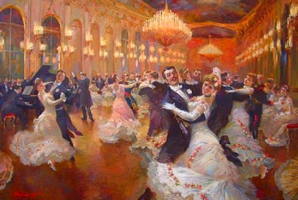 The Waltz is the oldest of the ballroom dances, dating from the middle of the 8th century. The German Ländler, a folk dance, is supposed to be the forerunner of the waltz. During this time period, a dance developed that was called the Walzer, a word owing its origin to the Latin word volvere, which indicates a rotating motion. Napoleon's invading soldiers spread the Walt from Germany to Paris; then the dance glided across the channel to England, and finally made its way to the United States.
The Waltz is the oldest of the ballroom dances, dating from the middle of the 8th century. The German Ländler, a folk dance, is supposed to be the forerunner of the waltz. During this time period, a dance developed that was called the Walzer, a word owing its origin to the Latin word volvere, which indicates a rotating motion. Napoleon's invading soldiers spread the Walt from Germany to Paris; then the dance glided across the channel to England, and finally made its way to the United States.
It is not known exactly when the Waltz was introduced to the United States. It was probably brought to New York and Philadelphia at about the same time, and by the middle of the 19th century, was firmly established in American society. In the transition from country to town, the hopping of the Ländler, a dance known as Langaus, became a sliding step and stamping rotation was replaced by a gliding rotation.
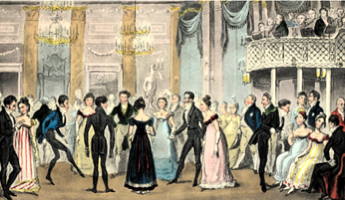 When the Waltz was first introduced into the ballrooms of the world in the early years of the 19th century, it was met with outraged indignation, for it was the first dance where the couple danced in a modified closed position – with the man's hand around the lady's waist.
When the Waltz was first introduced into the ballrooms of the world in the early years of the 19th century, it was met with outraged indignation, for it was the first dance where the couple danced in a modified closed position – with the man's hand around the lady's waist.
In a 1771 German novel, a high-minded character complains about the newly introduced Waltz among aristocrats thus: "But when he put his arm around her, pressed her to his breast, cavorted with her in the shameless, indecent whirling-dance of the Germans and engaged in a familiarity that broke all the bounds of good breeding – then my silent misery turned into burning rage."
Beginning about 1830, the Waltz was given a tremendous boost by two Austria composers: Lanner and Strauss. They set the standard for the Viennese Waltz, a very fast version played at about 55 to 60 measures per minute. The fast tempo did indeed present problems. Much of the enjoyment of the new dance was lost in the continual strain to keep up with the music.
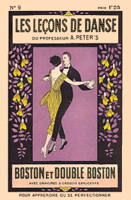 The Viennese custom is to slightly anticipate the second beat of each measure, making it sound as if the third is late and creating a certain buoyancy. The younger Strauss (Johann Strauss II) would sometimes break up the one-two-three of the melody with a one-two pattern in the accompaniment along with other rhythms, maintaining the 3/4 meter while causing the dancers to dance a two-step Waltz.
The Viennese custom is to slightly anticipate the second beat of each measure, making it sound as if the third is late and creating a certain buoyancy. The younger Strauss (Johann Strauss II) would sometimes break up the one-two-three of the melody with a one-two pattern in the accompaniment along with other rhythms, maintaining the 3/4 meter while causing the dancers to dance a two-step Waltz.
During the latter part of the 19th century, Waltzes were being written to a slower tempo than the original Viennese rhythm. Around the close of the 19th century, in the United States, the Boston was introduced. It is a slower Waltz with long gliding steps; there were fewer and slower turns and more forward and backward movement than in the Viennese Waltz. This version eventually stimulated the development of the English or International style that continues today. The American style Waltz is similar to the International style except that the American style has open dance positions and the dancers' legs pass instead of close.
Shocking many when it was first introduced, the Waltz became fashionable in Vienna around the 1780s, spreading to many other countries in the years to follow. It became fashionable in Britain during the Regency period. Diarist Thomas Raikes later recounted that "No event ever produced so great a sensation as the introduction of the Waltz in 1813." Almack's, the most exclusive club in London, permitted the Waltz, though the entry in the Oxford English Dictionary shows that it was considered "riotous and indecent" as late as 1825. The Waltz, and especially its closed position, became the example for the creation of may other ballroom dances. Subsequently, new types of Waltz have developed, including may folk and several ballroom dances.
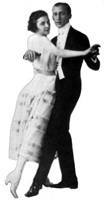
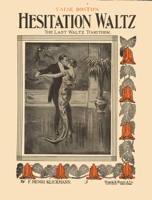 In the 1910s, a form called the Hesitation Waltz was introduced by Vernon and Irene Castle. It incorporated "hesitations" and was danced to fast music. A hesitation is basically a halt on the standing foot during the full Waltz measure, with the moving foot suspended in the air or slowly dragged. Although the Hesitation Waltz is no longer danced, some of its step patterns are still in use today.
In the 1910s, a form called the Hesitation Waltz was introduced by Vernon and Irene Castle. It incorporated "hesitations" and was danced to fast music. A hesitation is basically a halt on the standing foot during the full Waltz measure, with the moving foot suspended in the air or slowly dragged. Although the Hesitation Waltz is no longer danced, some of its step patterns are still in use today.
Local Variations of the Waltz
In California, the Waltz was banned by mission priests until after 1834 because of the "closed" dance position. Thereafter, a Spanish Waltz was danced. This Spanish Waltz was a combination of dancing around the room in closed position, and a "formation" dance of two couples facing each other and performing a sequence of steps. Valse a Trois Temps was the "earliest" Waltz step, and the Rye Waltz was favored as a couple dance.
In traditional Irish music, the Waltz was taught by traveling dancing masters to those who could afford their lessons during the 19th century. By the end of that century, the dance spread to the middle and lower classes of Irish society and traditional triple-tune tunes and songs were altered to fit the Waltz rhythm. During the 20th century, the Waltz found a distinctively Irish playing style in the hands of céilidh musicians at dances.
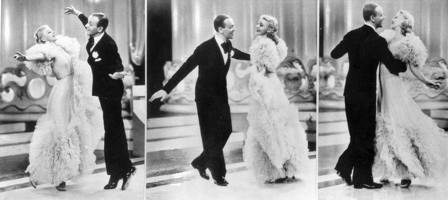 International standard Waltz has only closed figures, that is, the couple never breaks the embrace. The American style Waltz, part of the American smooth ballroom dance syllabus, in contrast to the International standard Waltz, involves breaking contact almost entirely in some figures. For example, the "syncopated side by side with spin" includes a free spin for both partners. Open rolls are another good example of an open dance figure, in which the follower alternates between the lead's left and right sides, with the lead's left or right arm (alone) providing the lead. Waltzes were the staple of many American musicals and films, including "Waltz in Swing Time," starring Fred Astaire and Ginger Rodgers.
International standard Waltz has only closed figures, that is, the couple never breaks the embrace. The American style Waltz, part of the American smooth ballroom dance syllabus, in contrast to the International standard Waltz, involves breaking contact almost entirely in some figures. For example, the "syncopated side by side with spin" includes a free spin for both partners. Open rolls are another good example of an open dance figure, in which the follower alternates between the lead's left and right sides, with the lead's left or right arm (alone) providing the lead. Waltzes were the staple of many American musicals and films, including "Waltz in Swing Time," starring Fred Astaire and Ginger Rodgers.
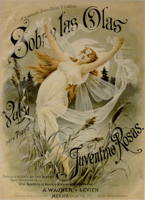 The Mexican Waltz (Vals Mexicano) follows the same basic rhythmic pattern as the standard Waltz, but the melodies reflect a strong Spanish influence. Mexico's Juventino Rosas wrote Sobre las Olas (Over the Waves), commonly known in the Unites States as a circus song played during a trapeze show.
The Mexican Waltz (Vals Mexicano) follows the same basic rhythmic pattern as the standard Waltz, but the melodies reflect a strong Spanish influence. Mexico's Juventino Rosas wrote Sobre las Olas (Over the Waves), commonly known in the Unites States as a circus song played during a trapeze show.
The Scandinavian Waltz, danced as a part of a Scandinavian folk dance, can be fast or slow, but the dancers are always rotating.
The Cajun Waltz is danced progressively around the floor and is characterized by the subtle swaying of the hips and a step very close to ordinary walking. It is danced entirely in the closed position.
The Valse-Musette, a form of Waltz popular in France, started in the late 19th century. The Cross-step Waltza, originally the French Valse Bostona, developed in the early 20th century and is popular in social Waltz groups today.
In contemporary ballroom dance, the fast versions of the Waltz are called Viennese Waltz, as opposed to the slow Waltz. Today, both versions are extremely popular with dancers of all ages.
Much of this material was taken from the Internet with an
original source from Ron & Rebecca Kellen and Bogie
of the Mile High Ballroom of Prescott, Arizona.
Printed in Folk Dance Scene, April 2016.